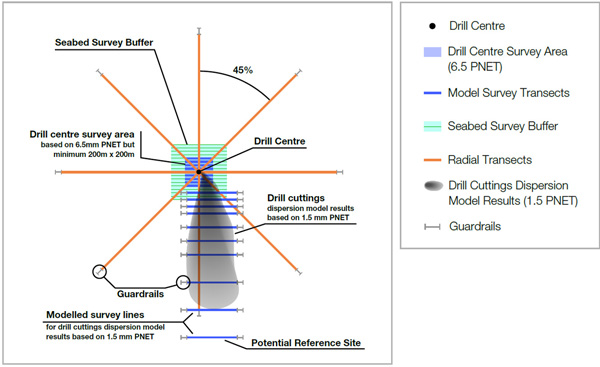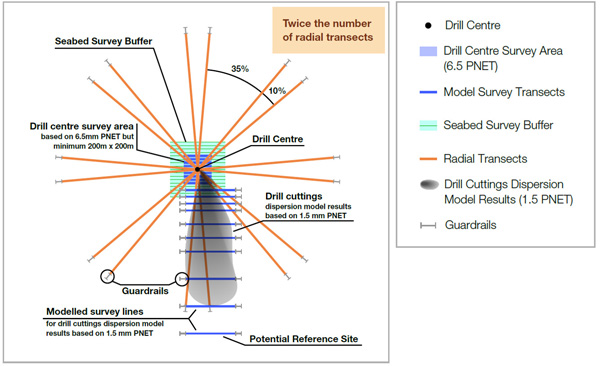Summary of regional guidance on measures to protect corals and sponges during exploratory drilling in the Canada – Newfoundland and Labrador Offshore Area
On this page
Context
This guidance outlines measures that should be implemented before, during, and after exploratory drilling in the Canada-Newfoundland and Labrador Offshore Area to minimize impacts on habitat-forming aggregations of corals and sponges.
It has been developed in response to current regulations and policies relevant to exploratory drilling, including conditions of project-specific Environmental Assessments (EA), the Regulations Respecting Excluded Physical Activities (Newfoundland and Labrador Offshore Exploratory Wells), and the Government of Canada’s 2022 Marine Other Effective Area-Based Conservation Measures (OECM) Guidance which reflects the 2019 federal marine OECM Protection Standard and the 2018 Convention on Biological Diversity OECM guidance. The Marine OECM guidance specifies that existing or foreseeable activities in federal marine OECMs continue to be assessed on a case- by-case basis to ensure that risks to the OECM’s conservation objectives have been avoided or mitigated effectively.
The guidance considers:
- best available scientific information and advice
- international standards
- regional industry practices
- feedback from interested parties
It takes a balanced approach to maintain high levels of environmental protection during exploratory drilling programs. DFO will continue to use a scientific, risk-based approach to assess industrial activities, such as petroleum exploration, on a case-by-case basis. The guidance will be updated in response to new science, regional experience, and advancement of best practices.
Application
Unless otherwise specified, the mitigation measures set out in this guidance apply to the pre-, during, and post-drilling phases of exploratory drilling programs inside and outside OECMs in the Canada-Newfoundland and Labrador Offshore Area. This guidance is not meant to be prescriptive, rather provides transparency on expectations by outlining a process for proponents to meet regulatory and policy requirements, and providing certainty for industry.
This guidance will inform provision of advice and recommendations by DFO to the Canada-Newfoundland and Labrador Offshore Petroleum Board (C-NLOPB) concerning mitigations to minimize impacts to corals and sponges. It is also to be used by proponents in designing and planning exploratory drilling projects or programs. The C-NLOPB will continue to issue operations authorizations for exploratory drilling that consider and reflect advice and recommendations from DFO.
While this guidance serves as a guideline, it is not conclusive in all matters. It outlines recommendations, and does not replace established EA conditions or other regulatory requirements.
Phase 1: Pre-drilling
Outside OECMs
Seabed Investigation Survey
The Seabed Investigation Survey to establish baseline data for coral and sponge abundance, density, condition, and distribution of functional groups (see Figure 1) should incorporate:
- visual survey data of sufficient quality and quantity to identify corals and sponges to the functional group level along each entire transect, and log report to be provided to DFO
- survey of the drill center survey area to 6.5 mm Predicted No Effects Threshold (PNET), with a minimum area of 200 m x 200 m
- survey of modeled drill cuttings dispersion area based on 1.5 mm PNET
- 8 radial transects from the proposed well location based on 1.5 mm PNET, plus survey extension guardrails of 10% to account for uncertainty
- survey buffer of 100 m added around the drill center survey area to accommodate for well relocation. Buffer will be increased if drill center survey area is larger than 200 m x 200 m
- surveys at reference sites outside of expected zone of influence to determine levels of environmental change relative to baseline conditions
- sediment collection at reference sites, if chosen as method for measuring drill cuttings extent and thickness
- if applicable, surveys at anchor locations
- the Seabed Investigation Survey Plan and results are to be reviewed by the C-NLOPB and DFO prior to drilling
Relocation protocol
If technically feasible, the well location should be relocated within the drill center survey area as a measure to avoid and/or minimize impacts to aggregations of habitat-forming corals and sponges. This relocation could occur in response to a recommendation from DFO or a real-time decision by a proponent, with supporting rationale provided to the C-NLOPB and DFO. Both options will consider:
- abundance and spatial distribution of the 5 functional groups:
- sea pens
- small gorgonians
- large gorgonians
- black corals
- sponges (see Annex A, Technical document)
- vulnerability of functional groups (e.g black corals are rare on continental shelf with a longer life span and rigid fragile skeleton)
- overlapping functional groups
- the footprint of the well and associated modelling (i.e. smothering as a result of drill cuttings)
Inside OECMs
Seabed Investigation Survey
All measures recommended outside OECMs should be followed and implemented inside OECMs. In addition, the Seabed Investigation Survey (see Figure 2) should be enhanced as follows:
- survey is to have 16 radial transects from the proposed well location
- if technically feasible, one sample of the dominant species for each of the functional groups that are prevalent throughout the survey area should be collected during the pre-drill survey or in the immediate vicinity of the proposed well location just prior to drilling, with the exception of black corals
- close-up still photos should be taken of the proposed well location during the pre-drill survey or in the immediate vicinity just prior to drilling
Relocation as part of OECM Plan
The OECM Plan must be submitted to DFO and the C-NLOPB at least 90 days before the start of the drilling program, and is to include a detailed description of measures that have been or will be implemented to avoid and/or minimize impacts on corals and sponges. There will be an elevated expectation to demonstrate avoidance or minimizing of impacts to corals and sponges inside OECMs.
Phase 2: During drilling
Outside OECMs
Management of drill cuttings and muds
In areas with aggregations of habitat-forming corals and/or sponges as determined by the Seabed Investigation Survey, measures should be implemented to avoid and/or minimize impacts on them, including, where technically feasible:
- redirection of drill cuttings, such as by a subsea cuttings transport system (CTS) to a specified discharge location away from the well.
If relocation and redirection are not technically feasible, other mitigations will be assessed and determined in consultation with the C-NLOPB and DFO, including:
- use of subsea pump to return drill cuttings and fluids to the drilling rig:
- Riserless Mud Recovery (RMR) systems enable the separation of drill cuttings and fluids on the drilling rig (DNV, 2013), followed by a method of disposal:
- untreated discharge: Collected water-based drill cuttings are separated with a shaker and discharged from the drilling rig at the surface (DNV, 2013)
- coarse slurrification and discharge: Drill cuttings are ground to finer particles, mixed with water, and discharged from the drilling rig at the surface (DNV, 2013)
- slurrification and reuse as spud mud: Drill cuttings are processed by grinding to finer particles, and mixed with water and chemicals to get specifications of drilling fluid (DNV, 2013) or
- coarse slurrification of separated cuttings for disposal at the sea floor: Consists of a combination of CTS and mud recovery techniques (DNV, 2013)
- Riserless Mud Recovery (RMR) systems enable the separation of drill cuttings and fluids on the drilling rig (DNV, 2013), followed by a method of disposal:
Inside OECMs
Management of drill cuttings and muds
All measures recommended outside OECMs should be followed and implemented inside OECMs.
If relocation and redirection are not technically feasible, mitigations in addition to those identified for outside of OECMs will be assessed and determined in consultation with the C-NLOPB and DFO, including directional drilling.
The OECM Plan is to include a detailed description of measures considered and to be implemented, including those described at left, in order to limit adverse effects from drill cut- tings and muds on OECM conservation objectives. There will be an elevated expectation to demonstrate avoidance or minimizing of impacts to corals and sponges in OECMs.
Phase 3: Post-drilling
Outside OECMs
Follow-up and monitoring program
The program is designed to measure and verify the accuracy of model predictions, impacts on corals and sponges, and the effectiveness of mitigation measures.
The follow-up and monitoring plan will be submitted to the C-NLOPB and reviewed by DFO. Follow-up and monitoring surveys will:
- provide visual survey data of sufficient quality and quantity to identify corals and sponges to the functional group level along entire transect, and log report to be provided to DFO
- have the same design as the pre-drill survey (Figure 1)
- measure the extent and thickness of drill cuttings (e.g. one method could include sediment collection)
- assessment of deposition of drill cuttings and muds on corals and sponges to verify the drill cuttings dispersion model
- show spatial distribution of corals and sponges
- compare the abundance, densities, and condition of corals and sponges to pre-drill results to verify effectiveness of mitigation measures
- results of follow-up and monitoring will be submitted to the C-NLOPB no later than 60 days after drilling
Inside OECMs
Follow-up and monitoring program
All measures recommended outside OECMs should be followed and implemented inside OECMs. In addition, the follow-up and monitoring program should be enhanced as follows:
- the survey is to have 16 radial transects
- close-up still photos in the immediate area around the wellhead once drilling is complete. Photo of the entire colony with scale bar or laser points, as well as close-up photos of key features (e.g. polyps, attachment to substrate)

Pre-drill seabed investigation survey design – outside OECMs. For illustrative purposes only.
Description
The drill centre is surrounded by a box representing the drill centre survey area, in which drill cuttings are expected to accumulate to a thickness of at least 6.5 mm. This box is nested within a larger box representing the seabed survey buffer. There are also 8 radial transects originating at the drill centre and fanning out like spokes on a wheel. These transects are spaced 45 degrees apart from one another. South of the drill centre is a dark plume representing the area in which drill cuttings will accumulate to a thickness of at least 1.5 mm, as predicted by the drill cuttings dispersion model results. Running perpendicular to the model plume are 10 model survey transects which span the full width of the model plume and are capped on each end by additional guardrails. The model survey transect furthest from the drill centre is located just outside the model plume and is labeled as a potential reference site.

Pre-drill seabed investigation survey design – inside OECMs. For illustrative purposes only.
Description
The drill centre is surrounded by a box representing the drill centre survey area, in which drill cuttings are expected to accumulate to a thickness of at least 6.5 mm. This box is nested within a larger box representing the seabed survey buffer. There are 16 radial transects originating at the drill centre and fanning out like spokes on a wheel. These transects are drawn in pairs spaced 10 degrees apart from one another, with 35 degrees between each pair. A highlighted box at the top of the schematic indicates that this is twice the number of radial transects, compared to the survey design for outside of OECMs. South of the drill centre is a dark plume representing the area in which drill cuttings will accumulate to a thickness of at least 1.5 mm, as predicted by the drill cuttings dispersion model results. Running perpendicular to the model plume are 10 model survey transects which span the full width of the model plume and are capped
- Date modified: